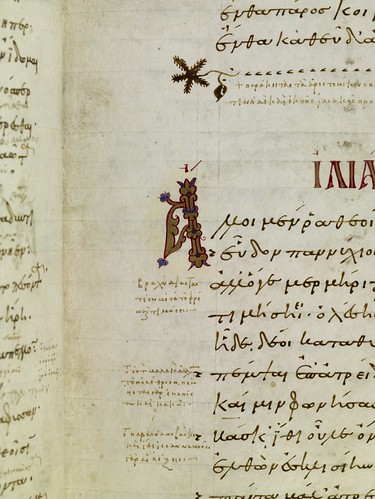Greetings,
I’m one of the course instructors, Teresa Dobson. You’ll find my bio on the ETEC 540 course site in the “Prefatory Materials” section.
This image is published under the Creative Commons Attribution-Noncommercial-Share Alike 3.0 License. It shows a manuscript held in the Homer Multitext Project digital archives. As we’ll learn in future course readings (Walter Ong, Orality and Literacy), texts like Homer’s Iliad are written versions of oral poems and their origin is reflected in the use of language in the text.
There are a number of interesting features of this manuscript: illumination, marginalia, and so on. As technologies for writing have developed, some features of earlier book forms have been incorporated and others have been dropped. Bolter (2001) calls this process “remediation.” In this course we’ll look at the process of remediation over a number of centuries with a view to contextualizing present shifts in writing technologies historically.
Finally, it is interesting to note that one effect of the rise of digital technologies is that rare manuscripts such as this one are now far more widely accessible to readers than they have been before, and their accessibility through digital means has revived interest in such manuscripts and in book culture generally. The interplay among various technologies for knowledge diffusion is complex and intriguing. I hope you’ll find the next few weeks in which we consider this interplay interesting.
I look forward to viewing your contributions to the ETEC 540 communications spaces in the next weeks!
Cheers,
Teresa




Great to have you as our instructor. I am looking forward to a great learning experience.
Everton